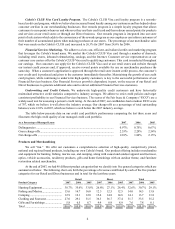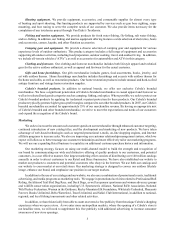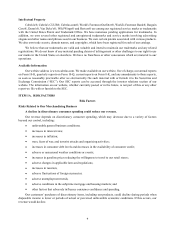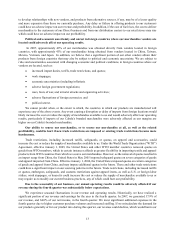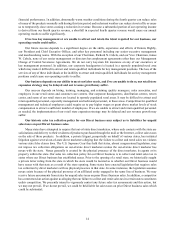Cabela's 2007 Annual Report Download - page 13
Download and view the complete annual report
Please find page 13 of the 2007 Cabela's annual report below. You can navigate through the pages in the report by either clicking on the pages listed below, or by using the keyword search tool below to find specific information within the annual report.7
Highlights during 2007 from our management information systems impacting our multi-channel distribution
included:
• We rolled out to our retail stores in the first half of 2007 a new warehouse management system for tracking
inventory in a multi-channel environment allowing us to more accurately and timely route inventory for
distribution.
• We created in-house software to interface with our inventory replenishment system to ensure this system
always has valid inventory counts so it will accurately replenish store merchandise, helping to increase
customer satisfaction and sales. We also added additional vendors onto our inventory replenishment
system.
• We continued working on our merchandise management system, which consolidates information related
to our item master, vendor master, and purchase order system, and provides the foundation for how we
account for and manage our merchandise process.
Employees
At the end of 2007, we employed approximately 15,000 employees, approximately 7,600 of whom were employed
full time. We use part-time and temporary workers to supplement our labor force at peak times during our third
and fourth quarters. None of our employees are represented by a labor union or are party to a collective bargaining
agreement. We have not experienced any work stoppages and consider our relationship with our employees to be
good.
Seasonality
We experience seasonal fluctuations in our revenue and operating results. Due to buying patterns around the
holidays and the opening of hunting seasons, our merchandise revenue is traditionally higher in the third and fourth
quarters than in the first and second quarters, and we typically earn a disproportionate share of our operating income
in the fourth quarter. Because of our retail store expansion, and fixed costs associated with retail stores, our quarterly
operating income may be further impacted by these seasonal fluctuations. Refer to Note 24 to our consolidated
financial statements for quarterly results of operations for 2007 and 2006.
Government Regulation
Regulation of Our Bank Subsidiary. Our wholly-owned bank subsidiary is a Nebraska state-chartered bank
with deposits insured by the Bank Insurance Fund of the Federal Deposit Insurance Corporation (“FDIC”). Our bank
subsidiary is subject to comprehensive regulation and periodic examination by the Nebraska Department of Banking
and Finance (“NDBF”) and the FDIC. We also are registered as a bank holding company with the NDBF and as such
are subject to periodic examination by the NDBF.
Our bank subsidiary does not qualify as a “bank” under the Bank Holding Company Act of 1956, as amended,
(“BHCA”), because it is in compliance with a credit card bank exemption from the BHCA. If it failed to meet the
credit card bank exemption criteria, its status as an insured depository institution would make us subject to the
provisions of the BHCA, including restrictions as to the types of business activities in which a bank holding company
and its affiliates may engage. We could be required to either divest our bank subsidiary or divest or cease any
activities not permissible for a bank holding company and its affiliates, including our Retail and Direct businesses.
While the consequences of being subject to regulation under the BHCA would be severe, we believe that the risk of
being subject to the BHCA is minimal as a result of the precautions we have taken in structuring our business.
There are various federal and Nebraska laws and regulations relating to minimum regulatory capital requirements
and requirements concerning the payment of dividends from net profits or surplus, restrictions governing transactions
between an insured depository institution and its affiliates, and general federal and Nebraska regulatory oversight
to prevent unsafe or unsound practices. At the end of 2007, our bank subsidiary met the requirements for a “well
capitalized” institution, the highest of the Federal Deposit Insurance Corporation Improvement Act’s (“FDICIA”) five
capital ratio levels. A “well capitalized” classification should not necessarily be viewed as describing the condition or
future prospects of a depository institution, including our bank subsidiary.









